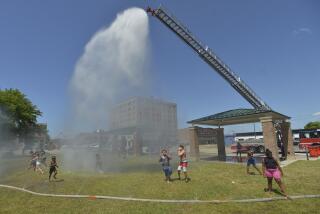Cold in East Ends Heat Wave but Not Drought
- Share via
A cold front accompanied by rain and strong winds pushed through Northeastern states on Friday, ending a five-day heat wave, but forecasters said there was no relief in sight for drought-plagued farmers in much of the Midwest.
As the cold front swept into the Northeast from Canada, midday temperatures dropped into the 70s, well below the mid-90s readings that contributed to the deaths of at least 20 people in the Boston area earlier in the week.
In northern Massachusetts, the heat wave was broken by strong thunderstorms that brought hail and wind gusts up to 50 m.p.h. to Methuen. The Baltimore area was hit by hail and heavy rain that knocked out power to about 22,000 customers, officials said.
Chilly weather was reported in upper Michigan, northeastern Minnesota and northern Wisconsin, where overnight temperatures dipped into the 30s and 40s.
Scattered showers and thunderstorms stretched from the central plains through the lower Mississippi Valley into the northern and mid-Atlantic states on Friday. Several points in northwestern and north-central Iowa received half an inch of rain or more, but other areas got nothing more than clouds.
Dan McCarthy of the National Weather Service said the rainfall was so spotty that it brought “a little relief to very dry areas, but not nearly enough.”
Iowa state extension climatologist Elwynn Taylor said Friday’s rain barely made a dent in the amount of moisture needed. He said dry counties in northeastern Iowa need 5 inches of rain to get back to normal growing conditions. The rest of the state needs between 2 and 4 inches.
Hot, dry weather is searing crops in the northern plains, parts of the Corn Belt, Texas and the South. It has driven up grain prices, sparked fear of higher grocery prices and has grounded barges on shriveled river channels.
Along the Mississippi River, the U.S. Army Corps of Engineers increased its dredging operation Friday, trying to clear a path for hundreds of barges stranded by low water levels. The attempt to dredge the river to the minimum 9-foot depth was not expected to be completed until Sunday. The Mississippi is at its lowest levels since authorities began keeping records in 1872.
More to Read
Sign up for Essential California
The most important California stories and recommendations in your inbox every morning.
You may occasionally receive promotional content from the Los Angeles Times.













